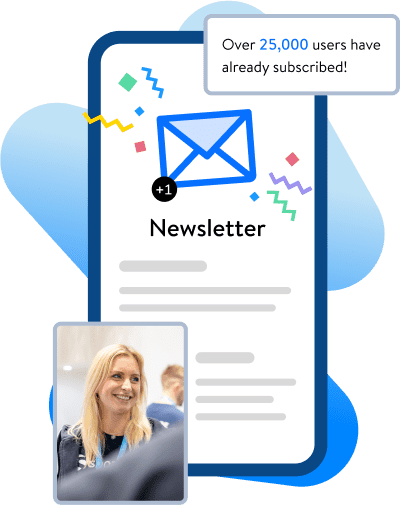
Imagine a customer with poor eyesight visits your online shop. The font is large enough, the contrast is right - but when trying to select a product using the keyboard, it gets stuck. He breaks off the visit, not because your offer is bad, but because the shop lets him down at the wrong moment.
The Accessibility Strengthening Act (BFSG) makes this technical basis mandatory from June 28, 2025.
By choosing a accessible theme that already meets all legal requirements, you will not only save time-consuming retrofits, but also benefit immediately from stronger SEO rankings, faster loading times, and higher conversion rates—all without compromising on design or frustrating detours. Instead of struggling through complex legal texts, here you get the direct solution: In just three steps, you will not only make your shop legally compliant, but also increase the user experience and your competitive advantage.
⏰ Why today is the best day to start working on accessibility
Legal cretainty and minimised risk Your shop must comply with WCAG 2.1 AA by June 28, 2025. Anyone who fails to do so risks warnings or fines. By taking action early, you can avoid this stress and comply with the law before it becomes expensive.
SEO-Power and Performance-Boost Accessible code is clear and streamlined. Loading times are significantly shorter, which Google appreciates. Faster loading times mean fewer bounces and better rankings.
First-class user experience Clear contrasts, visible focus frames, and a navigation that can be controlled entirely via the keyboard create a pleasant shopping experience for all customers. Visitors feel welcomed and are less likely to abandon their purchase, as they can proceed to checkout without any obstacles.
Stronger brand image and competitive advantage Accessibility demonstrates responsibility and appreciation for every customer. This strengthens your image and makes you more likable than competitors who are still hesitating. At the same time, you will reach new target groups and secure additional sales.
Accessible content is not only important for people with permanent disabilities. Older users or people with temporary disabilities also benefit from clearly structured and easy-to-understand content.
Exceptions for micro-enterprises and B2B: The law provides for exceptions. Micro-enterprises or purely B2B-oriented shops may be exempt. Therefore, check individually whether your shop is affected, but even with exceptions, keep in mind that accessibility still increases conversion, SEO and customer satisfaction.

🟥 Step 1: The right theme as a foundation for accessibility
Today, an accessible theme must be able to do more than just use simple HTML; it must fully cover WCAG 2.1 AA and remove the typical stumbling blocks for you as a shop operator.
So before you tweak individual functions or make optimizations, you need a solid technical foundation, because an accessible theme ensures that your shop automatically meets important requirements by default. This saves time, nerves and expensive rework and creates space for the really important things.
What an accessible theme should definitely offer:
Semantic HTML structure Content must be clearly labeled so that screen readers, keyboard controls and search engines can easily identify what is where.
Keyboard usability with visible focus All navigation elements, buttons, forms, and interactive areas should be easily operable via keyboard, including a clearly visible focus state.
Generous click and touch surfaces Buttons, icons and slider arrows are also easily accessible on smartphones, which leads to fewer misclicks and higher conversion.
High contrast ratios and flexible color adjustment An accessible theme offers high-contrast settings by default, but can also be flexibly adjusted without compromising readability or usability.
Flexible, responsive layout without horizontal scrolling A 100% responsive grid adapts to any width – from 320 pixels to 4K – and works in portrait and landscape mode.
Updatability and future-proofing The theme should be updated regularly, always taking into account the latest WCAG guidelines and further developments of the Shopware platform.
Performance and SEO optimization Accessibility and technical optimization go hand in hand as an optimized theme ensures fast loading times and better findability in search engines.

Why ThemeWare® is an optimal solution
ThemeWare® provides the technical basis for an accessible shop – automatically, by default and without additional effort. All essential requirements of WCAG 2.1 AA, such as visible focus frames, clear structures, keyboard control, and high-contrast default settings, are already implemented as standard.
It doesn't matter whether you want to build a new online shop or replace an existing design. With an accessible theme such as ThemeWare®, you save yourself time-consuming reworking of functions and you can concentrate on what really matters right from the start — strong content and an accessible shopping experience for your customers.
Try ThemeWare® free for 30 days – directly in the Shopware Store. No risk, but plenty of new possibilities.
🟥 Step 2: Toolbar as a comfort level at one touch of a button
Before deciding on an extension from the Shopware Store, check whether it meets the basic requirements. Only then is it worth taking a look at the price, support, etc.
What an accessibility toolbar should definitely offer
GDPR-compliant data storage The settings should be saved locally – without external servers. This protects the privacy of visitors and avoids warnings.
Flexible placement Toolbar, top bar, or compact floating icon: You should be able to choose where the element appears so that it does not interfer with the navigation path or the design.
Personalized settings Once you increase contrast, you always increase contrast. The toolbar must save the selected options across sessions, otherwise it will frustrate users instead of supporting them.
Essential comfort functions A powerful toolbar allows you to increase contrast, invert colors or display them in grayscale, enlarge the font size, switch to an easy-to-read standard font, hide images or enlarge the cursor with a single click.
Full keyboard & screen reader usability The toolbar itself must of course also be accessible – including visible focus and ARIA labels.
Lean code for powerful performance Do not reload oversized scripts or fonts. The toolbar must not bring your Core Web Vitals to their knees.
Easy integration & update capability Ideally, you should install a Shopware plugin that is regularly maintained so that you don't have to do any manual tinkering.
A toolbar complements your accessible design, it does not replace it. Only the combination of step 1 (technical basis), step 2 (toolbar), and step 3 (accessible content) will lead you safely to WCAG compliance.

Our recommendation: Accessibility 1-Click Toolbar – WCAG Boost
To ensure that every Shopware retailer can immediately offer a user-friendly convenience level, we are making our “Accessibility 1-Click Toolbar” available as a free app in the Shopware Store. The app fulfills all of the above points, works completely locally, and can be activated in just a few minutes—even without ThemeWare®.
Instantly enable your customers to personalize your store for an accessible user experience without technical guesswork.
🟥 Step 3: Your content makes the difference
Accessibility doesn't end with the theme or the toolbar, it starts with what you publish in your shop every day. You are the key to an accessible online shop.
When using a theme, ideally it will cover the technical aspects for you, and the toolbar will make things easier for your visitors, but you are responsible for most of the WCAG requirements. So that you are not left to your own devices, you have free access to our Quick Start Toolkit in addition to our 1-Click Toolbar. This contains practical checklists, mini-guides, tutorials, and add-on recommendations. With this, you have everything you need to make a difference and achieve true accessibility.
These contents are your responsibility
Expressive Alt texts for images Every screenshot, every product image, every expressive icon needs expressive alternative text. Short, precise, without keyword spam.
Clean headline structure One H1 per page. Then H2, H3, etc. – neatly structured in order that screen readers, Google, and your customers will quickly understand the shop.
Text instead of image text Avoid embedding important information in images. If you do (e.g., in advertising banners), make sure that the content is also available as real text in HTML or is described alternatively.
Offering video content in an accessible manner Product videos require subtitles and ideally a transcript or a brief summary. If your video is important for the purchase decision, it should be understandable even without sound and without sight.
Contrast & readability of your own content When creating your own content, make sure that the text is easy to read, i.e. of sufficient size, with clear contrasts and formatted in an understandable way. Nothing should be blurry or difficult to see, especially on mobile devices or when zooming.
Language & comprehernsibility Use simple, clear, and active language. Avoid foreign words, technical terms, and overly long, convoluted sentences, especially in help pages, FAQs, or explanatory texts.
Tip: Alternatively, you can find our free Accessibility Quick Start Toolkit in the ThemeWare® Service Portal. Even if you don't use our theme or toolbar.

Conclusion: This is how you turn a duty into real added value
Shops do have to meet legal standards such as WCAG 2.1 AA from June 28, 2025. But instead of seeing accessibility as just a requirement, you can use it as a real competitive advantage.
With a solid technical foundation, convenient options for your customers, and accessible content, you can offer a shopping experience that complies with legal requirements while strengthening SEO, conversion and brand perceptionIn the article “Accessible online shop by 2025 – what you should know” Shopware points out that 25% of the top 500 shops in Germany and 98% of the leading international websites are not yet accessible. Implementing accessibility in your shop ensures legal certainty and new sales opportunities.
FAQ: Frequently asked questions about accessible themes
For whom is an accessible theme relevant?
As a general rule, if your shop sells products or services to consumers, you must comply with the requirements of WCAG 2.1 AA by June 28, 2025. However, there are exceptions, for example for micro-enterprises or pure B2B shops. Please check whether your shop is affected in individual cases – regardless of this, accessibility always offers advantages for usability, SEO, and customer satisfaction.
Is an accessible theme sufficient to meet all requirements?
A accessible theme such as ThemeWare® covers the entire technical basis. To ensure that your online shop is completely accessible, you should also create accessible content such as texts, images, and videos. Our free Quick Start Toolkit will provide you with support.
What distinguishes a truly accessible theme from conventional themes?
A truly accessible theme goes far beyond contrast adjustments. It takes into account, for example, focus guidance for keyboard operation, semantically correct HTML structures, flexible responsive design, and an updatable architecture that keeps pace with future Shopware and WCAG standards.
What are my benefits of accessibility beyond legal requirements?
An accessible shop improves the user experience for all visitors, reduces bouncing rates, improves SEO results, and demonstrates social responsibility. This not only strengthens the brand image, but also creates a real competitive advantage.
Can I easily check accessibility myself?
Yes, with our free Quick Start Toolkit, you will receive checklists and instructions to test and optimize your shop for accessibility independently and easily. The 1-click toolbar additionally helps you to make typical barriers visible.











